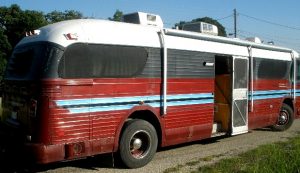Recently, I received a physical copy of VONULIFE, March 1973 and have been in the process of digitizing this 80,000+ word publication. As expected, it’s taking some time, but I figured I’d drop you another sneak peek. This article is by Al Fry, one of the main editors of VONULIFE, wherein he discusses what he’s learned about rigging up a bus/van for nomadic living. Please enjoy, share, and keep a lookout for the full publication!
If you would like to help with the digitization process, we ARE looking for transcriptionists and proofreaders. Send me an email or contact us through the Facistbook page.

Mobile living started for me the day I passed a car lot which had a dilapidated $150 travel trailer which I couldn’t pass up for the price. I pulled it post haste to a friend’s secluded orange orchard and decided that this sure might be the way to solve the problem of rent. One thing led to another and we would up pulling that trailer all over sunny Southern California, often sagging from the overload of junk or jetsam.
Pretty soon I got tired of trying to find suitable free spots to leave it while exploring an area or working, so we went on to an ancient U.P.S. truck which should have solved the problem but didn’t. What it did do was point out the many mechanical problems one could run into. Sparing the details I hope that what scant bit of experience we later piled up will help someone else going the same path.
Several step-vans later I finally figured I had my ultimate vehicle when fate interceded again and I had a mate with a son and dogs. Well, to shorten the story, I laid out about 1500 bills with trembling fingers and became the hesitant owner of a gigantic 35 foot “48” Crown bus. Vans are one thing but flat-front buses are something else again.
Over the next six months or so we gained a lot of savvy on just how cheap one of these things can go together and still be presentable. The first surprising bit of luck was learning that one can usually get seconds and left overs from the trailer and camper builders who seem to be scattered all of S. Calif. Paneling for instance never ran us over a dollar a sheet and the more expensive hardware like sliding valve toilet, small water heater, and stove were usually less than a fourth of the new cost. An initial trip to our local dump quickly supplied us with the 2 x 4’s and insulation to get things underway. ($2 a load is average scavenging rate.) Most of the lesser hardware came from swap meets where many trailer factory workers brought a lot of miscellaneous, and persons often unloaded unique gear from the past. Prize possessions on the “unique” list were one brass lever-handle water pump to supplement the electric jobby and various pieces of antique hardware and bric-a-brac.
I have always searched high and low to get my hands on good stainless steel tanks for putting under my vans, but I stumbled across a real winner when I found out about the industrial Teflon-lined barrels now in use. These barrels can be found in 25 or 50 gallon sizes, and for a few dollars you have a rustproof first-class water or holding tank. Any industrial section of a large city will have scads of them around and some of the big buses will have enough room underneath to put the big 50 gallon jobs. I used heavy strap iron cradles to hold them and connected little electric pumps to them although I am about to replace this constant line pressure pump with a constant barrel pressure air pump which will use less to push a given amount of water. They are a little more trouble free as a bonus. We used some surplus transparent hose to hook up all the faucets. I have found that ordinary garden hose is too chintzy and rubber taints all the water that goes through it. Camper supply stores have a good cheap hose. I had given copper some thought but one good accidental freeze would have split it open and who can afford copper. I have insulated pipes and tanks but didn’t on the bus in hopes a half-filled round tank wouldn’t split and the very flexable [flexible] clear stuff would give enough.
Generally speaking I have found that the more insulation one can get UNDER er rig the better. The sides and top should get insulated but often the factory insulation will suffice IF one puts a layer of something over the metal interior. Wood paneling does the job. Rubber-backed carpet glued down with contact cement is even better and regular carpet is better than nothing. Our bus bedroom is carpeted ceiling to floor in warm carpet that cost next to nothing because it was leftover material – large pieces would need cutting up anyway.
By far, the best thing to have on a floor is rubber backed commercial carpet although it is really hard to find at any reasonable price. Linoleum is okay if it isn’t in squares, which soon loosen up. And long shag rug is totally impractical.
Some innovations that are very nice include a clear plastic or glass skylight and light proof window covers all around. The skylight can be incorporated into the ventilation cover if it is fairly large and the savings in lighting fuel will make the effort worth while. In cold weather this skylight should have a double layer of glass as well as the windows if possible, although a plastic film can be put on in a pinch.
Cold weather is really hard to combat in a bus or van and I always try to have sliding heavy curtains to cut off window areas and the front end driver window area from the more insulated section. After trying about everything I could think of to heat my various mobile shelters, I found the solution in the good ol’ wood stove. The pressure and wick kerosene burners, the catalytic heaters, LP gas – they all have drawbacks for the full time “outbacker” or penny pincher. If at all possible give the LITTLE pot bellied wood burner a chance – wherever you go, the fuel will probably be laying around waiting for you. A good armload will keep you snug all day and a little coal or hardwood will get you through the night. Even if daytime smoke will give you away where you are you can always stoke up after dark.
Get a good quality (will have a grate) stove with a five inch pipe and fix yourself a fairly heat-resistant and leakproof opening. The heat can be excessive at ceiling if a vent (preferably adjustable) is not available. If your rig is paneled at ceiling you will need a larger pipe to catch heat around the smaller five-inch pipe and carry it out so as not to scorch wood. Set the stove near and facing the door so you won’t dribble splinters and ashes on your floor, and set it on a metal catch basin or scorch sheet. You can fix a carrier under your rig to hold your stovepipe when you are in cities and prefer to be less conspicuous. It is usually simple to put a choke (damper) in the pipe to adjust the flu draft and save wood. And add a screen spark arrestor. Ashley Stoves are the ticket for cabins and such, but the little flicker of flame required for a tight little van can be had from most any stick burner.
As far as name brand goes, keep in mind that you will probably wind up needing parts sooner or later and off-make vehicles can be a waste of all your loving labor if parts are scarce. Buses are really “bad news” when they start to have mechanical problems.
Dual wheels are desirable even though they need a little more gas to push them along – seems like I just keep collecting the exciting little goodies that civilization fosters and a single-wheeled rig I had got to the point of sinking down in warm parking lot asphalt pavement.
I believe in smaller engines but this is also derived from my penny-pinching approach which in turn comes from my dislike of sweating out my life for some members of the domination class.
Problems can occur with fire and I have parts gleaned from a rig that went up in flames from carelessness. Another friend lost a good converted van when he loaned it out to his good but insolvent friend. Provide for every emergency and take double precautions.
Still and all, considering the good and bad points, van and bus living is about the best money’s worth of shelter to be had and, like adding rooms to a house, one can always get another one.



